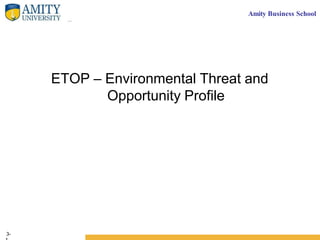
Module 3- Strategic Analysis-1.pptx
- 1. Amity Business School ETOP – Environmental Threat and Opportunity Profile 3-
- 2. Amity Business School ETOP 3- The preparation of ETOP involves dividing the environment into different sectors and then analyzing the impact of each sector on the organization.
- 4. • Environment analysis results in a mass of information related to forces in the environment . • Structuring of environmental issues is necessary to make them meaning full for strategy formulation.
- 5. ETOP involves: • Dividing the environment into different sectors . Each sectors can be subdivided into sub sectors. • Analyzing the impact of each sector and subsector on the organization. Describe the impact in the form of a statement.
- 6. ETOP FOR BICYCLE COMPANY Environmental sectors Nature of impact Impact of each sector Economic Growing affluence among urban consumers, rising disposable incomes & living standards. Market Organized sector a virtual oligopoly with 4 major manufacturers, buyers critical & better informed, overall industry growth rate not encouraging, growth rate for niche market like sports, trekking etc is high. International Global imports growing but India’s share shrinking, major importers are the US & EU but India exports mainly to Africa.
- 7. Political Bicycle principal mode of transport for low & middle income, Industry too small to draw attention. Regulatory Parts & components reserved for SSI, bicycle industry a thrust area for exports, Social Environment & health friendly transport option, wide usage, as recreation, convenient in traffic, customers preference
- 8. Supplier Mostly ancillaries in small-scale sector supply parts & components, rising steel prices, industrial concentration in Punjab & Tamilnadu. Technological Up gradation in progress, import of machinery simple, product innovations ongoing like battery operated & lightweight foldable cycles
- 9. Advantage of ETOP • Provides a clear picture of which sector and sub sectors have favorable impact on the organization. • Helps interpret the result of environment analysis. • The organization can assess its competitive position. • Appropriate strategies can be formulated to take advantage of opportunities and counter the threat.
- 10. In this session, we have discussed about: • ETOP process involves dividing the environment into different environmental sectors and then analyzing the impact of each sector on the organization. • ETOP gives a clear picture to the strategies about each aspect of the business environment, the various individual factors within each sector which affect the business favorably or otherwise.
- 11. Amity Business School SAP Strategic Advantage Profile (SAP) is a summary statement which provides an overview of advantages and disadvantages in key areas likely to affect future operations of an organization. There are generally five functional areas in most of organisations • Production or OperationØ • Finance or AccountingØ • Marketing or DistributionØ • Human Resource & Corporate Planning • Research & Development 3-
- 12. Amity Business School SAP – Maruti,SWIGGY
- 13. Amity Business School Porter Five Force 3-
- 14. Amity Business School The Five-Forces Model of Competition 3-
- 15. Amity Business School The Five-Forces Model 3- • Rivalry among competing firms – Most powerful of the five forces – Focus on competitive advantage of strategies over other firms
- 16. Amity Business School The Five-Forces Model 3-
- 17. Amity Business School The Five-Forces Model 3- • Potential Entry of New Competitors – Barriers to entry are important – Quality, pricing, and marketing can overcome barriers
- 18. Amity Business School Barriers to Entry • Need to gain economies of scale quickly • Need to gain technology and specialized know- how • Lack of experience • Strong customer loyalty – Cadbury , Maruti , Paytm • Strong brand preferences • Large capital requirements – coca – Cola • Lack of adequate distribution channels – Coca Cola
- 19. Amity Business School Barriers to Entry 3- • Government regulatory policies • Tariffs • Lack of access to raw materials • Possession of patents • Undesirable locations • Counterattack by entrenched firms • Potential saturation of the market
- 20. Amity Business School The Five-Forces Model 3- • Potential development of substitute products – Pressure increases when: • Prices of substitutes decrease • Consumers’ switching costs decrease
- 21. Amity Business School The Five-Forces Model 3- • Bargaining Power of Suppliers is increased when there are: – Large numbers of suppliers. – Few substitutes. – Costs of switching raw materials is high. • Backward integration is gaining control or ownership of suppliers, product oriented vs customer oriented . • Forward (M->WS->R->C) , • backward (c->R->WS->M).
- 22. Amity Business School The Five-Forces Model 3- • Bargaining power of consumers – Customers being concentrated or buying in volume affects intensity of competition. – Consumer power is higher where products are standard or undifferentiated.(KFC).American tourist , thomson cook .
- 23. Amity Business School Scenario Analysis/SWOT Analysis 3-
- 24. Amity Business School The Matching Stage 3- • The Strengths-Weaknesses- Opportunities-Threats (SWOT) Matrix helps managers develop four types of strategies: – SO (strengths-opportunities) Strategies – WO (weaknesses-opportunities) Strategies – ST (strengths-threats) Strategies – WT (weaknesses-threats) Strategies
- 25. Amity Business School A SWOT Matrix for a Retail Computer Store 3-
- 26. Amity Business School A SWOT Matrix for a Retail Computer Store 3-
- 27. Amity Business School SWOT – Coca Cola • Strength – Brand , Supply Chain Control • Weakness – Health Awareness • Opportunity • Threat 3-
- 28. Amity Business School Value Chain Analysis 3-
- 29. Amity Business School Value Chain Analysis 3-
- 30. Amity Business School Value Chain Analysis (VCA) 3- • Value chain analysis (VCA) – refers to the process whereby a firm determines the costs associated with organizational activities from purchasing raw materials to manufacturing product(s) to marketing those products – aims to identify where low-cost advantages or disadvantages exist anywhere along the value chain from raw material to customer service activities
- 31. Environmental analysis and dealing with uncertainty